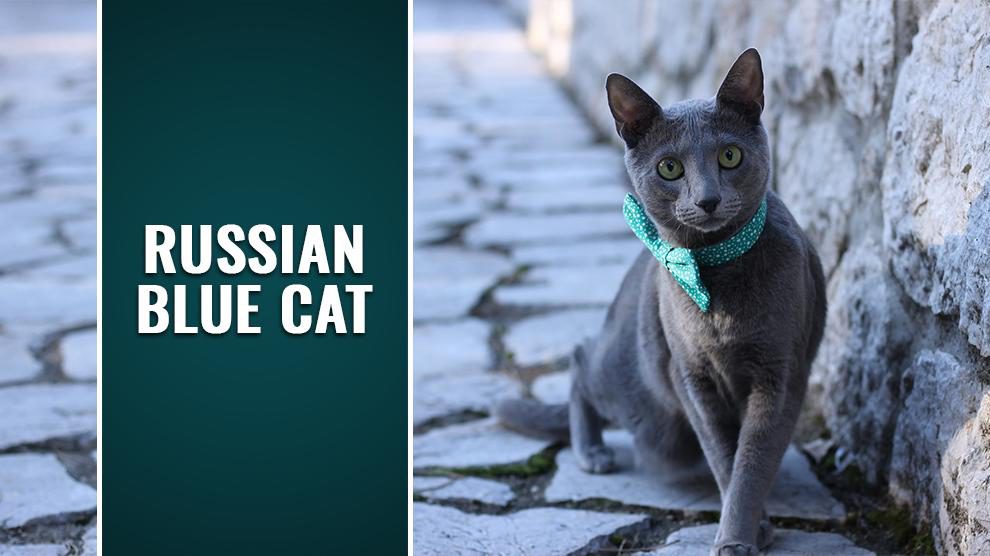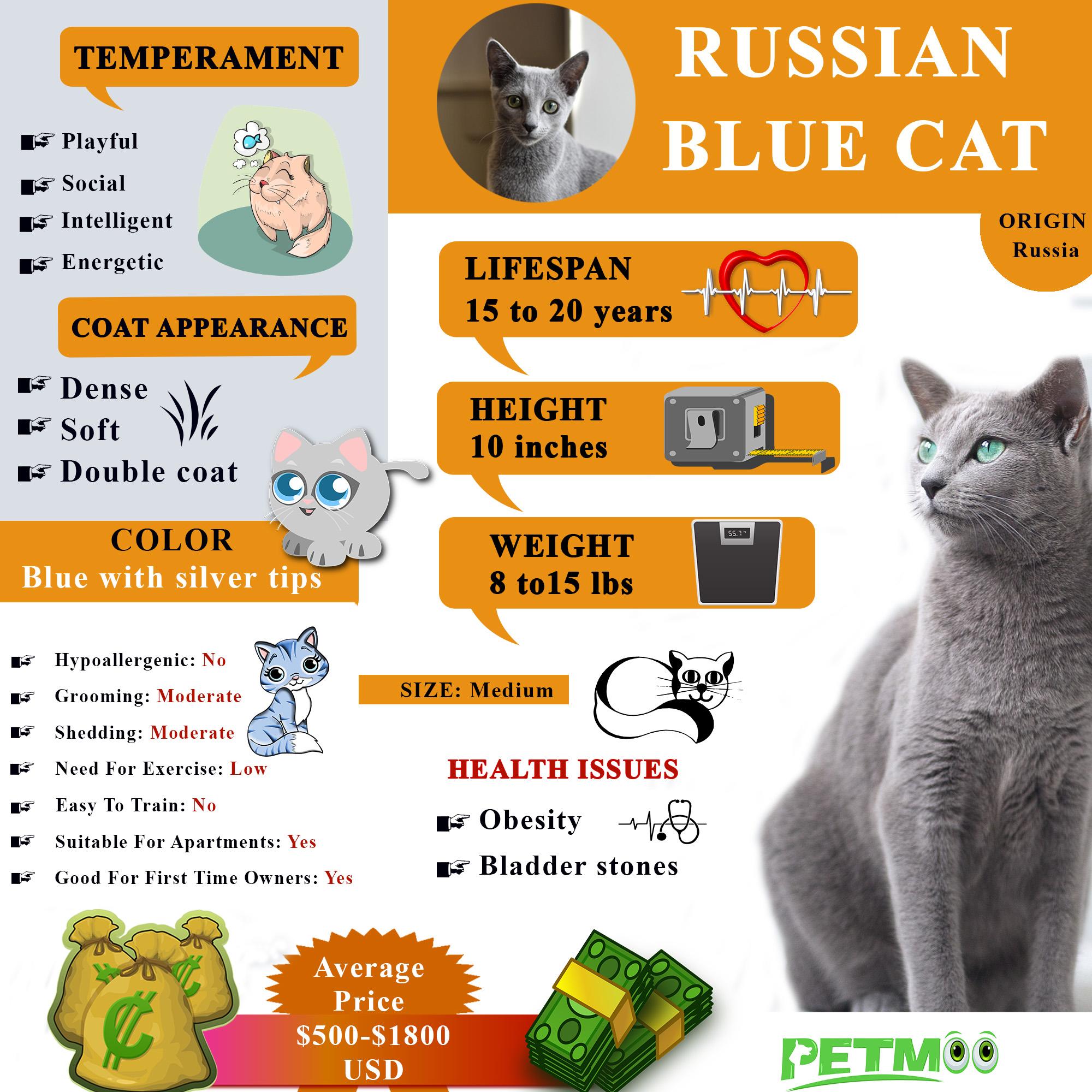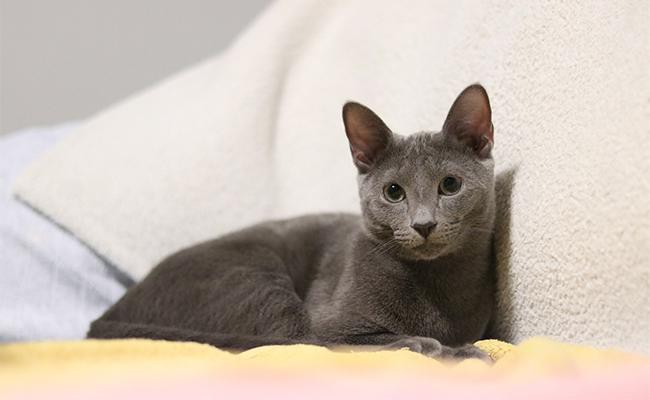Cat Pregnancy Calculator And Timeline
Looking for a smiling, charming, green-eyed cat? Russian Blue cat is the purrfect choice for you!
The name will tell you that it’s a Russian breed with a blue coat. But, the breed’s trademark is the silver casting on its blue coat! It will make you awestruck with its round, large, emerald-green eyes that are wide-set.
Wearing the natural smile, it best suits for any family who has great love on it! An intelligent and well-behaved feline, the Russian Blue cat is also a wonderful choice for people prone to allergies.
You can also expect this cat to sense your mood right from greeting you at the door to fetching a toy at the playtime. Easy to train, it is playful and can spend time alone when you’re away. And, it is an easy-to-maintain cat, too!
Let’s know more about this wonderful breed in this article.
Russian Blue Cat Breed Characteristics
- Origin: Archangel Isles, Russia
- Size: Medium
- Lifespan: 15 to 20 years
- Height: 10 inches
- Weight: 8 to15 lbs
- Coat Appearance: Dense, soft, double coat
- Coat Colors: Blue with silver tips
- Temperament: Playful, social, intelligent, energetic
- Good With Children: Yes
- Intelligence Level: High
- Good With Pets: Yes
- Hypoallergenic: Yes
- Grooming: Less
- Shedding: Moderate
- Need For Exercise: High
- Easy To Train: Yes
- Good For First Time Owners: Yes
- Health Issues: Obesity, Bladder stones
- Litter Size: 3 (average)
- Average Price: $400-$3000
Russian Blue Cat Origin
A belief exists that the Russian blue cat originates from Archangel Isles, Russia. The British sailors might have brought these cats from the White Sea port town of Archangel.
In 1871, this cat had the first public appearance in the name of Archangel Cat at the Crystal Palace in London. The Russian Blue cat was solid blue, short-haired with dense, thick and glossy coats at that time. And, the British Blue breed had many fans compared with this cat.
The Governing Council of the Cat Fancy recognized this breed later and granted a class of its own in 1912. But, the breed’s popularity declined due to World War II.
Later, breeders produced these cats by mating the British Blues with Bluepoint Siamese. The Scandinavian breeders also involved in the production of Russian blues.
They crossed the blue cats from Finland with similar colored Siamese cats.
But, the British breeders weren’t happy on the change in the shape and personality of the Russian Blue cat. Later, breeders crossed the Scandinavian cats with the British Blues to produce this breed.
Finally, the Russian blue cat had the silver-blue coat color.
In the 1900s, the first Russian Blue cats arrived the United States of America. In 1949, the Cat Fanciers’ Association (CFA) registered this breed. And in 1964, a male Russian Blue cat named GC Maja Acre Igor II won a CFA Grand Championship.
But, the “father” of the modern standard Russian Blue was GC Felinest Flying High of Velva. Flying High performed well at shows as a kitten and produced 21 kittens through its bloodline.
Six among them became Grand Champions and two received the distinguished merit. And, one was a National Winner (GC NW Velva’s Blue Viking), which won 7th Best Cat in 1971 and 2nd Best Cat in 1972.
Russian Blue Cat Appearance And Coat Colors
Russian blues will give you a charming expression with its triangular-shaped head. Having a broad forehead, large ears, and straight nose, its look is splendid with a natural smile.
It shows brilliance in its emerald-green eyes. Despite being thin, it is a strong, muscular cat and its thick fur hides the neck and shoulders. Its legs are long enough to run at high speed and its paws are round with pinky lavender shade pads.
Russian Blue Cat Coat Colors
The Russian blue cat will appeal you with its dense, soft, silvery, double coat. The appearance of its coat reveals its ability to accustom to cold weather.
This cat stands out for its coat color. It may look gray, but the coat color is even, bright blue with silver-tipped hairs which give a luxurious look.
Russian Blue Cat Size And Lifespan
The Russian blue cat generally weighs around 8 to 15 pounds and stands tall at 10 inches at the shoulder. This breed is healthy, generally. And, you can expect it to live for about 15 to 20 years.
Russian Blue Cat Personality
The Russian Blue feline will be a special addition to your family because of many good qualities. It will be
- An affectionate and reserved feline – This breed has the tendency to attach to one person in a family and feels shy toward strangers. But, it will interact with the guests to your home after it knows that they are an acceptable company for it.
- Cautious breed – The Russian blues are cautious and their strong sense of observing the surrounding helps for its survival.
- Child-friendly cat – The Russian Blue cat gets along well with children in your family.
- Humorous feline – This cat has a good sense of humor and entertains you with its talent. But, make sure you laugh with it and not at it.
- Social cat and self-entertainer– These cats are social and don’t mind when you are away. And, it is capable of entertaining itself during alone time.
- Sweet, cute companion – The Russian Blue cat’s temperament is sweet. And, it is a gentle, cute, loving companion once it feels comfortable with you. It loves to follow you everywhere at home and sometimes will ride on your shoulder.
How To Train Your Russian Blue Cat?
The Russian blues will mature in a slow manner! But, don’t think that training this breed is a fearsome task. It is easy-to-train this well-behaved feline.
It pleases the trainer by learning the tricks in a quick manner. This cat will come out of its shell after getting a little push from its master. Socialization, obedience and reward-based training will help it to gain more love from people.
1. Socialization training
Generally, the Russian blues will feel shy toward strangers. But with proper socialization training from an early age, it will enjoy interacting with people and travel with them. And, you will feel easy to provide training for it.
2. Obedience training
It is advisable to provide this training when it is young. If you find the cat displaying undesirable behavior, be strong and stop your feline from doing so.
3. Reward training
This kind of training can enhance the pleasing behavior in your furry friend. Give your cat treats as rewards as a way of praising when it performs the activities well. It also appreciates a pat on its head.
4. Leash Training
This training will give your feline the outdoor walks a happy experience.
- Choose a lightweight leash that is comfortable for your cat to wear.
- Place the leash close to the cat’s neck and ensure that your tabby doesn’t get alarmed when using it for the first time.
- You should be kind and calm while providing this training.
- Your tabby will get used to it by repeating the training.
It is always better to know the dos and don’ts while providing training to any cat breed. So, we provide a few tips for you to make the training wonderful.
Russian Blue Cat Training Tips
- The Russian blues are sensitive. So, don’t shout or yell at it while providing training.
- Be kind, patient and consistent in your training.
- Don’t prolong the training sessions. Keep the sessions short.
- This cat will get hurt if ignored. So, always provide attention to avoid fear and anxiety in them!
- Be thoughtful and considerate to it!
The Russian blues have a quiet reputation. But, they will impress you with their playful nature. Fetching is its favorite activity. It also loves to chase after sunbeams or toys.
Eve, it is able to learn the meanings for more words. So, tricks and puzzle toys can challenge their intelligence. It also has the ability to open the doors and to get into cabinets. So, you can often see him reclining in a window.
The Russian blues have a good memory, too. So, you can stimulate its physical and mental health in many ways.
Pointers
The Russian Blue cats are good jumpers. You can either use pointers or sticks for this activity.
- At the start, set the target at a reachable height.
- Then, increase the target in a gradual manner.
- After the Russian blue reaches the target, give it treats for encouragement.
- Make it do this in a repetitive manner by repeating the “Target-Click-Treat” steps.
Toys
As this breed has strong hunting instincts, a feathered fishing pole toy can be the perfect toy. But, place these types of toys in a cat-proof spot because
- It may eat the feathers or the string, which are not good for its digestive system, and
- Your tabby may tear it to shreds.
Russian Blue Cat Shedding And Grooming
The Russian blues are seasonal shedders. But, the amount of shedding is less in comparison with other cat breeds.
As it is a short-haired cat, daily brushing its coat is not essential. But, weekly brushing will help its coat to be healthy.
And, it enjoys your company and will sit along with you while you comb or brush it. So, it is easy to maintain this breed.
- Some authorities advise that brushing the coat twice or three a week will help to remove dead hairs. Brushing will also help for the even distribution of oils in its skin.
- Bathing is also not necessary unless they are dirty and during shedding times for the quick removal of excess hair. But, ensure that you are using a shampoo designed for cats while you bath it.
- Brush the teeth regularly with a pet-friendly toothpaste for good dental health and fresh breath.
- Trim its nails regularly.
- Check its ears for dirt or any infection at least weekly once. Use a cotton ball and pet ear cleaner to wipe the dirt (don’t use a cotton swab). In cases of excess dirt or inflammation or if your tabby shakes its head or scratches its ears, have an appointment with the vet.
- Keep its litter box
Some owners report that poor diet and lifestyle contribute more shedding in their Russian blues. But, a poor diet can cause heavy shedding in almost any cat breed. Also, if your tabby spends most of its time outdoors, it tends to shed more.
Russian Blue Cat Food
Diet and nutrition play a major role in the development of your tabby. Russian blue cat doesn’t need specific nutrition for its growth.
Generally, they are food lovers. But, they may overeat sometimes, which leads to obesity.
Russian blues are perfect at its food schedule, too! You should be vigilant in the feeding amount and the feeding schedule.
But, the best way to prevent this cat from obesity is to measure its food and to provide it only at the scheduled times in a day.
- Feed your Russian Blue measured amounts of cat food at.
- Feed the Russian blues in measured quantities at regular intervals twice or thrice times a day.
- Don’t free-feed these cats and avoid feeding more cat treats to them!
- Stick to its food schedule.
- Avoid feeding scraps to them as they are unhealthy to it.
- It is vital not to leave this cat without food. This will lead them to have more snacks.
- Have a talk with the veterinarian about the best food to feed this cat.
Keeping this cat in good health condition will avoid weight-related health problems. And, it will help this cat to have a long life span of 15 years.
It is also important to ensure that everyone at your home knows about the overeating tendency of these cats.
Russian Blue Cat Names
Want to name your gleaming, green-eyed Russian friend? Go beyond the ordinary cat names.
The Russian culture, Russian food, and famous Russian people might have inspired you. Finding names in such categories may result in an exuberant name for your Russian Blue!
Your Russian tabby will definitely respond to its name as it is eager to learn and loves to converse with you. But, it is always better to keep in mind a few things while you choose a name for this cat.
- Choose a simple name that is easy to call as well.
- Don’t choose a name that sounds like cat commands.
- Generally, felines respond better to names having the long “e” or “ee” sound! Your tabby will recognize such names in a short span of time.
Russian Blue Cat Male Names
- Ash – A residue of a burnt substance, gray in color
- Byron – Name of a poet
- Gena – Meaning “noble” in the Russian language
- Moscow – Capital of Russia
- Rasputin – The renowned holy man’s name
- Yuri – The first man who traveled to outer space
- Valentin – Means “strong” in the Russian language
- Zane – Means “grace” in Arabic
- Vodka – An alcoholic beverage
- Vladimir – Name of the famous Russian ruler
Russian Blue Cat Female Names
- Blini – A famous Russian wheat pancake
- Elena – Meaning “light” in the Italian language
- Iris – A blue flower
- Kasha – Name of a famous Russian porridge
- Luka – Means “light” in the Russian language
- Polina – Meaning “small” in the language of Russia
- Rada – In Russian language, it means “pleased”
- Raisa – Means “rose” in Hebrew
- Sabina – Derived from the name of God Sabus
- Zoya – Meaning “life” in the Russian language
Russian Blue Cat Interesting Facts
Every feline has a few interesting facts. The Russian Blue tabby is not an exception to it!
- The Russian blue cat named “Marty”, owned by the actor Chris Torres, was the inspiration for the “Nyan Cat” meme.
- The silver coat of this cat resulted from the diluted version of the gene responsible for black hairs. So, if you mate two Russian Blues together, you’ll get a litter of gray kittens.
- Folklore says that these cats were kept in the chambers of newborns to chase the evil spirits away.
- A Russian Blue kitten was acted as a trained assassin in the Cats & Dogs.
- Cat fans of “Tom & Jerry” considered Tom as Russian Blue tabby.
- A belief prevails that some of the Russian blue cats are born with “ghost stripes.” They are nothing but faint tabby markings which disappear when they mature.
Russian Blue Cat Health Problems
These cats are generally healthy and have no genetic disorders. So, you can expect it to enjoy its teen life and live for at least 18 years.
The only concern on this breed is obesity. In rare cases, it may be prone to bladder stones. Have a discussion with your vet to ensure that your tabby is up to date on vaccines, routine testing, dental care, and annual examination.
Are Russian Blue Cats Hypoallergenic?
Yes. But, you need to know some important information on this.
People often consider Russian blue tabbies for their hypoallergenic nature. But, you can’t say any cat breed as non-allergenic. That is, some cat breeds will suit allergy sufferers and this breed adds to the list of those cats.
Dander is the major cause of allergies. Allergic people are sensitive to a protein “Fel d 1,” which is present in the skin cells, dried urine, and saliva of tabbies.
Russian Blue naturally produces less amount of “Fel d 1” than other cats. So, this breed is suitable for people having mild allergies.
Russian Blue Cat Price And Breeders
This cat is not much expensive. It costs anywhere between $400 and $3000 on average. But, you can expect to pay shipping charges around $175 and $300 for transportation. High shipping charges may occur due to the far away breeders.
Russian Blue Cat Breeders in the United States of America
- Royal Blues Russian Blue Cattery
Sarah Fosnight
royalbluescattery@gmail.com
Tel: (937) 726-3622 - Praire Home Cattery
prairiehome99@yahoo.com - M & B Russian Blues
Rockford, IL
mbrussianblues@gmail.com














